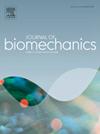Step velocity asymmetry rather than step length asymmetry is updated in split-belt treadmill adaptation
IF 2.4
3区 医学
Q3 BIOPHYSICS
引用次数: 0
Abstract
When discrepancies between planned and actual movements arise due to environmental changes, humans adjust movement parameters to achieve task goals. While motor adaptation has been extensively studied, the mechanisms involved in redundant movement parameters remain unclear. Split-belt treadmill adaptation, where each belt moves at a different speed, is an example of this phenomenon. Such adaptation initially induces gait asymmetry, which diminishes over time. Previous studies have postulated step length asymmetry as the target function; however, recent evidence challenges this assumption, leaving the target function undefined. This study investigates the target function by analyzing step parameter asymmetry using the goal-equivalent manifold and generalization predictability. The goal-equivalent manifold assesses whether adaptation is close to optimal in minimizing step parameter asymmetry, while generalization predictability reflects adaptation effects across different contexts, indicating potential target functions. We propose that step velocity asymmetry, rather than step length asymmetry, serves as the target function in split-belt treadmill adaptation. This framework facilitates the prediction and interpretation of both the learning process and the transfer of learning effects from trained to untrained conditions. In addition, it explains the overadaptation of step length asymmetry and the achievement of energy-efficient gait after adaptation. Therefore, we propose that step velocity asymmetry is the primary target function in split-belt treadmill adaptation.
求助全文
约1分钟内获得全文
求助全文
来源期刊

Journal of biomechanics
生物-工程:生物医学
CiteScore
5.10
自引率
4.20%
发文量
345
审稿时长
1 months
期刊介绍:
The Journal of Biomechanics publishes reports of original and substantial findings using the principles of mechanics to explore biological problems. Analytical, as well as experimental papers may be submitted, and the journal accepts original articles, surveys and perspective articles (usually by Editorial invitation only), book reviews and letters to the Editor. The criteria for acceptance of manuscripts include excellence, novelty, significance, clarity, conciseness and interest to the readership.
Papers published in the journal may cover a wide range of topics in biomechanics, including, but not limited to:
-Fundamental Topics - Biomechanics of the musculoskeletal, cardiovascular, and respiratory systems, mechanics of hard and soft tissues, biofluid mechanics, mechanics of prostheses and implant-tissue interfaces, mechanics of cells.
-Cardiovascular and Respiratory Biomechanics - Mechanics of blood-flow, air-flow, mechanics of the soft tissues, flow-tissue or flow-prosthesis interactions.
-Cell Biomechanics - Biomechanic analyses of cells, membranes and sub-cellular structures; the relationship of the mechanical environment to cell and tissue response.
-Dental Biomechanics - Design and analysis of dental tissues and prostheses, mechanics of chewing.
-Functional Tissue Engineering - The role of biomechanical factors in engineered tissue replacements and regenerative medicine.
-Injury Biomechanics - Mechanics of impact and trauma, dynamics of man-machine interaction.
-Molecular Biomechanics - Mechanical analyses of biomolecules.
-Orthopedic Biomechanics - Mechanics of fracture and fracture fixation, mechanics of implants and implant fixation, mechanics of bones and joints, wear of natural and artificial joints.
-Rehabilitation Biomechanics - Analyses of gait, mechanics of prosthetics and orthotics.
-Sports Biomechanics - Mechanical analyses of sports performance.
 求助内容:
求助内容: 应助结果提醒方式:
应助结果提醒方式:


